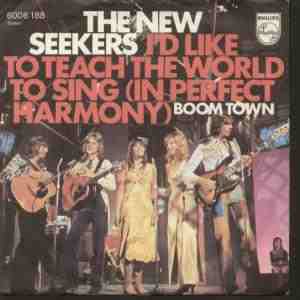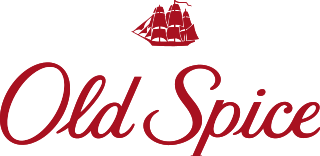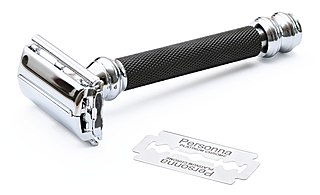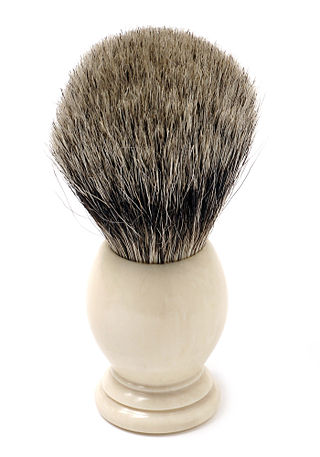
Burma-Shave was an American brand of brushless shaving cream, famous for its advertising gimmick of posting humorous rhyming poems on small sequential highway roadside signs.

Burma-Shave was an American brand of brushless shaving cream, famous for its advertising gimmick of posting humorous rhyming poems on small sequential highway roadside signs.
Burma-Shave was introduced in 1925 by the Burma-Vita company in Minneapolis owned by Clinton Odell. The company's original product was a liniment made of ingredients described as having come "from the Malay Peninsula and Burma" (hence its name). [1] Sales were sparse, and the company sought to expand sales by introducing a product with wider appeal.
The result was the Burma-Shave brand of brushless shaving cream and its supporting advertising program. Sales increased; at its peak, Burma-Shave was the second-highest-selling brushless shaving cream in the US. Sales declined in the 1950s, and in 1963 the company was sold to Philip Morris. Its well-known advertising signs were removed at that time. The brand decreased in visibility and eventually became the property of the American Safety Razor Company.
In 1997, the American Safety Razor Company reintroduced the Burma-Shave brand with a nostalgic shaving soap and brush kit, though the original Burma-Shave was a brushless shaving cream, and Burma-Shave's own roadside signs frequently ridiculed "Grandpa's old-fashioned shaving brush."

Burma-Shave sign series first appeared on U.S. Highway 65 near Lakeville, Minnesota, in 1926, and remained a major advertising component until 1963 in most of the contiguous United States. The first series read: Cheer up, face – the war is over! Burma-Shave. [2] The exceptions were Nevada (deemed to have insufficient road traffic), and Massachusetts (eliminated due to that state's high land rentals and roadside foliage). Typically, six consecutive small signs would be posted along the edge of highways, spaced for sequential reading by passing motorists. The last sign was almost always the name of the product. The signs were originally produced in two color combinations: red-and-white and orange-and-black, though the latter was eliminated after a few years. A special white-on-blue set of signs was developed for South Dakota, which restricted the color red on roadside signs to official warning notices.
This use of a series of small signs, each of which bore part of a commercial message, was a successful approach to highway advertising during the early years of highway travel, drawing the attention of passing motorists who were curious to learn the punchline. [3] As the Interstate system expanded in the late 1950s and vehicle speeds increased, it became more difficult to attract motorists' attention with small signs. When the company was acquired by Philip Morris, the signs were discontinued on advice of counsel. [4]
Some of the signs featured safety messages about speeding instead of advertisements.
Examples of Burma-Shave advertisements are at The House on the Rock in Spring Green, Wisconsin. Re-creations of Burma-Shave sign sets also appear on Arizona State Highway 66, part of the original U.S. Route 66, between Ash Fork, Arizona, and Kingman, Arizona (though they were not installed there by Burma-Shave during its original campaigns), and on Old U.S. Highway 30 near Ogden, Iowa. Other examples are displayed at The Henry Ford in Dearborn, Michigan, the Interstate 44 in Missouri rest area between Rolla and Springfield (which has old Route 66 building picnic structures), the Forney Transportation Museum in Denver, Colorado and the Virginia Museum of Transportation in Roanoke, Virginia.
The complete list of the 600 or so known sets of signs is listed in Sunday Drives [5] and in the last part of The Verse by the Side of the Road. [6] The content of the earliest signs is lost, but it is believed that the first recorded signs, for 1927 and soon after, are close to the originals. The first ones were prosaic advertisements. Generally the signs were printed with all capital letters. The style shown below is for readability:
As early as 1928, the writers were displaying a puckish sense of humor:
In 1929, the prosaic ads began to be replaced by actual verses on four signs, with the fifth sign merely a filler for the sixth:
Previously there were only two to four sets of signs per year. 1930 saw major growth in the company, and 19 sets of signs were produced. The writers recycled a previous joke. They continued to ridicule the "old" style of shaving. And they began to appeal to the wives as well:
In 1932, the company recognized the popularity of the signs with a self-referencing gimmick:
In 1935, the first known appearance of a road safety message appeared, combined with a punning sales pitch:
Safety messages began to increase in 1939, as these examples show. (The first of the four is a parody of "Paul Revere's Ride" by Henry Wadsworth Longfellow.)
In 1939 and subsequent years, demise of the signs was foreshadowed, as busy roadways approaching larger cities featured shortened versions of the slogans on one, two, or three signs – the exact count is not recorded. The puns include a play on the Maxwell House Coffee slogan, standard puns, and yet another reference to the "H" joke:
The war years found the company recycling a lot of their old signs, with new ones mostly focusing on World War II propaganda:
A 1944 advertisement in Life magazine ran:
1963 was the last year for the signs, most of which were repeats, including the final slogan, which had first appeared in 1953:
A number of films and television shows set between the 1920s and 1950s have used the Burma-Shave roadside billboards to help set the scene. Examples include Bonnie and Clyde , A River Runs Through It , The World's Fastest Indian , Stand By Me , Tom and Jerry , Rat Race , 'M*A*S*H and the pilot episode ("Genesis") of Quantum Leap . The long-running series Hee Haw borrowed the style for program bumpers, transitioning from one show segment to the next or to commercials.
The Flintstones episode "Divided We Sail" has Barney Rubble reading messages on a series of buoys that say, "If You're Queasy riding on the wave, just open your mouth. Shout Terra Firma Shave."
The final episode of the popular television series M*A*S*H featured a series of road signs in Korea "Hawk was gone, now he's here. Dance til dawn, give a cheer. Burma-Shave".
Roger Miller's song "Burma Shave" (the B-side to his 1961 single "Fair Swiss Maiden") has the singer musing that he's "seen a million rows of them little red poetic signs up and down the line", while reciting rhymes in the manner of the ads. Tom Waits' song "Burma-Shave" (from his 1977 album Foreign Affairs ) uses the signs as an allegory for an unknown destination. ("I guess I'm headed that-a-way, Just as long as it's paved, I guess you'd say I'm on my way to Burma-Shave") Chuck Suchy's song "Burma Shave Boogie" (from his 2008 album Unraveling Heart) incorporates several of the Burma Shave rhymes into its lyrics.
The pedestrian passageway between the 42nd Street–Port Authority Bus Terminal and Times Square–42nd Street stations in the New York City Subway system contains a piece of public art inspired by the Burma-Shave ads; Norman B. Colp's The Commuter's Lament, or A Close Shave consists of a series of signs attached to the roof of the passageway, displaying the following text: [12]
Several highway departments in the United States use signs in the same style to dispense travel safety advice to motorists.
Several writers of doggerel and humorously bad poetry (such as David Burge) often use "Burma Shave" as the last line of their poems to indicate their non-serious nature.
The word "burmashaving" is used in Canada to describe politicians holding signs and waving to traffic by the side of the road, a common sight during election campaigns. [13] [14]
During the Apollo 8 mission, a parody of 'Twas the Night Before Christmas written by Ken Young was transmitted to the mission, which referenced "A Burma-Shave sign saying 'Kilroy was here'." [15]

"I'd Like to Teach the World to Sing (In Perfect Harmony)" is a pop song that originated as "True Love and Apple Pie", by British hit songwriters Roger Cook and Roger Greenaway, and sung by Susan Shirley.

Shaving is the removal of hair, by using a razor or any other kind of bladed implement, to slice it down—to the level of the skin or otherwise. Shaving is most commonly practiced by men to remove their facial hair and by women to remove their leg and underarm hair. A man is called clean-shaven if he has had his beard entirely removed.

A billboard is a large outdoor advertising structure, typically found in high-traffic areas such as alongside busy roads. Billboards present large advertisements to passing pedestrians and drivers. Typically brands use billboards to build their brands or to push for their new products.

Old Spice is an American brand of male grooming products encompassing aftershaves, deodorants and antiperspirants, shampoos, body washes, and soaps. It is manufactured by Procter & Gamble.
McDonald's maintains an extensive advertising campaign. In addition to the usual media such as television, radio and newspaper ads, the company makes significant use of billboards and signage, and sponsors sporting events ranging from Little League to the FIFA World Cup and Olympic Games. The company also makes coolers of orange drink with their logo available for local events of all kinds. However, television ads remain the primary form of advertisement.

Snickers is a chocolate bar consisting of nougat topped with caramel and peanuts, all encased in milk chocolate. The bars are made by the American company Mars, Inc. The annual global sales of Snickers was over $3 billion as of 2012.

A razor is a bladed tool primarily used in the removal of body hair through the act of shaving. Kinds of razors include straight razors, safety razors, disposable razors, and electric razors.

A safety razor is a shaving implement with a protective device positioned between the edge of the blade and the skin. The initial purpose of these protective devices was to reduce the level of skill needed for injury-free shaving, thereby reducing the reliance on professional barbers.
Gillette is an American brand of safety razors and other personal care products including shaving supplies, owned by the multi-national corporation Procter & Gamble (P&G). Based in Boston, Massachusetts, United States, it was owned by The Gillette Company, a supplier of products under various brands until that company merged into P&G in 2005. The Gillette Company was founded by King C. Gillette in 1901 as a safety razor manufacturer.

"Sunny Jim" is the name of two completely unconnected characters used in advertising and product branding: (1) a cartoon character created to promote Force cereal, the first commercially successful wheat flake; (2) the name of a brand of peanut butter produced in the Seattle area. It also has been used as a form of address for men in general or to refer to those named James.

Starburst is the brand name of a box-shaped, fruit-flavoured soft taffy candy manufactured by The Wrigley Company, which is a subsidiary of Mars, Incorporated. Starburst has many different varieties, such as Tropical, Sour, FaveREDs, Watermelon, Very Berry, Superfruit, Summer Blast and Original.

Shaving cream or shave cream is a category of cream cosmetics used for shaving preparation. The purpose of shaving cream is to soften the hair by providing lubrication.
Benny Bell was an American singer-songwriter who reached popularity in the 1940s, with a comeback in the 1970s. He is remembered for his risqué but cheerfully optimistic songs.

A shaving brush or shave brush is a small brush with a handle parallel to the bristles used to make lather from shaving soap or shaving cream and apply it to the face when shaving. Shave brushes are often decorative; antique handles are often made from materials such as ivory or even gold, though the bristle load may be composed of any number of natural or synthetic materials. The shave brush is used most often today by "wet shavers" in tandem with a single- or double-edged safety razor or a straight razor. However, this is not always the case, as shavers of all varieties may employ the tool.

Noxzema is a brand of skin cleanser marketed by Unilever. Since 1914, it was sold in a small cobalt blue jar; but is now sold in a blue plastic jar. Noxzema contains camphor, menthol, phenol and eucalyptus, among other ingredients. Originally developed as a sunburn remedy, it is a type of cold cream or vanishing cream which is used as a facial cleanser and make-up remover.
"Winston tastes good like a cigarette should" is an advertising slogan that appeared in newspaper, magazine, radio, and television advertisements for Winston cigarettes, manufactured by R. J. Reynolds Tobacco Company. Reynolds used the slogan from Winston's introduction in 1954 until 1972. It is one of the best-known American tobacco advertising campaigns. In 1999, Advertising Age included the "Winston tastes good like a cigarette should" jingle in its list of the 10 best radio and television jingles in the United States during the 20th century.

Roadside assistance, also known as breakdown coverage, is a service that assists motorists, motorcyclists, or bicyclists whose vehicles have suffered a mechanical failure that either cannot be resolved by the motorist, or has prevented them from reasonably or effectively transporting the vehicle to an automobile repair shop. Roadside assistance employees respond to calls for service to inspect the vehicle and attempt to render appropriate repairs. Roadside assistance may be provided by departments of transportation, automobile associations, vehicle insurance providers, or dedicated roadside assistance organizations.
Barbasol is an American brand of shaving cream, aftershave, and disposable razors created by MIT Professor Frank Shields in 1919 in Indianapolis. It is currently owned by Perio, Inc.
American Safety Razor Company is a personal care brand founded in the early 20th century (1906) by a merging of the Gem Cutlery Company & Ever-Ready and has been a principal competitor to Gillette for a century and more. It is unrelated to the Gillette company which also used the name 'American Safety Razor Company' in 1901 until 1904 before it was renamed for its founder, King C. Gillette.
At the outset of the United States, leg and underarm hair removal was not a common practice for women. In fact, body hair had been viewed as a boon by Caucasian people, and therefore removal was not an imported practice from European settlers into the United States. The removal of armpit and leg hair by American women became a new practice in the early 20th century due to a confluence of multiple factors.